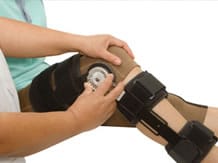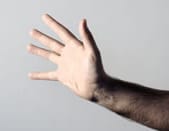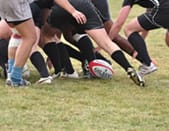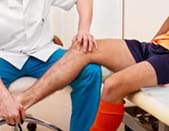Osteoarthritis is a chronic joint impairment progressively leading to cartilage destruction, characterised by pain when walking or performing a physical activity and eased with rest.
One existing therapeutic treatment approach (mainly for lower limb osteoarthritis) is the prescription of mechanical supports, called orthoses, intended to compensate and assist the deficient joint function. These devices are recommended, in particular, by the European League Against Rheumatism (EULAR)1 and the American College of Rheumatology (ACR)2 in the non-pharmacological treatment of knee osteoarthritis. Three types of orthoses are available for knees and ankles:

- Resting orthoses. These orthoses, made from a rigid component, immobilise the joint, thus excluding any corrective or functional effects. They are rarely prescribed in cases of lower limb osteoarthritis (7 to 10% of cases) and their efficacy has not been established.
- Flexible orthoses. Contrary to resting orthoses, these are elastic and non-adhesive, allowing their use with other devices. Between one quarter and one third of practitioners prescribe them frequently in cases of knee osteoarthritis. Studies have demonstrated that their use reduces pain and enhances short-term subjective improvement, though they do not provide any improvement in functional capacity3, 4.
- Articulated orthoses. These are functional devices consisting of external rods and hinges. Their efficacy has not been clearly established, even though it would appear that they reduce compressive loads transmitted to the joint surfaces in the context of internal femorotibial osteoarthritis5, 6, 7. According to some studies, they also appear to improve knee proprioception, vertical propulsion force8 and step symmetry9. Despite this, they their prescription rate remains low (23% of physicians systematically propose them, along with only 9% of rheumatologists), mainly because they have been associated with a range of side effects10, 11.
Foot orthoses, inserted into a shoe, or strapped on, are also available. These are routinely prescribed, in particular for knee osteoarthritis, though no specific recommendations have ever been made (type of orthosis, time worn, recipients) and most studies have concluded that their efficacy is limited12, or even non-existent13, 14. The theories put forward for modelling the action of these orthoses are precise, though they are based on insufficiently validated biomechanical concepts15.
Sources :
1 - American College of Rheumatology Subcommittee on Osteoarthritis Guidelines. Recommendations for the medical management of osteoarthritis of the hip and knee: 2000 update. Arthritis Rheum 2000;43:1905-15
2 - Jordan KM, Arden NK, Doherty M, et al. EULAR Recommendations 2003: an evidence based approach to the management of knee osteoarthritis: Report of a Task Force of the Standing Committee for International Clinical Studies Including Therapeutic Trials (ESCISIT). Ann Rheum Dis 2003;62:1145-55.
3 - Kirkley A, Webster-Bogaert S, Litchfield R, et al. The effect of bracing on varus gonarthrosis. J Bone Joint Surg 1999;81-A:539–484 - Berry H, Black C, Fernandes L, et al. Controlled trial of a knee support (Genutrain) in patients with osteoarthritis of the knee. Eur J Rheumatol Inflamm 1992;12:30–4.
5 - Pollo FE, Otis JC, Backus SI, et al. Reduction of medial compartment loads with valgus bracing of the osteoarthritic knee. Am J Sports Med 2002;30:414–21.
6 - Self BP, Greenwald RM, Pflaster DS. A biomechanical analysis of a medial unloading brace for osteoarthritis in the knee. Arthritis Care Res 2000;13:191–7.
7 - Katsuragawa Y, Fukui N, Nakamura K. Change of bone mineral density with valgus knee bracing. Int Orthop 1999;23:164–7.
8 - Richards JD, Sanchez-Ballester J, Jones RK, et al. A comparison of knee braces during walking for the treatment of osteoarthritis of the medial compartment of the knee. J Bone Joint Surg 2005;87-B:937–9.
9 -Draper ERC, Cable JM, Sanchez-Ballester J, et al. Improvement in function after valgus bracing of the knee. An analysis of gait symmetry. J Bone Joint Surg 2000;82-B:1001–5.
10 - Giori NJ. Load-shifting brace treatment for osteoarthritis of the knee: a minimum 2½-year follow-up study. J Rehabil Res Dev 2004;41:187–93.
11 - Liu K, Lao L, Asami T, et al. Clinical care of osteoarthritic knee with knee orthoses. Fukuoka Acta Med 1998;89:298–302.
12 - Brouwer RW, Jakma TS, Verhagen AP, et al. Braces and orthoses for treating osteoarthritis of the knee. Cochrane Database Syst Rev 2005. CD004020.
13 - Reilly KA, Barker KL, Shamley D. A systematic review of lateral wedge orthotics–how useful are they in the management of medial compartment osteoarthritis ? Knee 2006;13:177–83.
14 - Gelis A, Coudeyre E, Aboukrat P, et al. Feet insoles and knee osteoarthritis: evaluation of biomechanical and clinical effects from a literature review. Ann Readapt Med Phys 2005;48:682–9
15 - Anthony Gélisa, Emmanuel Coudeyreb, Christophe Hudryc, Jacques Pelissiera, Michel Reveld, François Rannoud, Is there an evidence-based efficacy for the use of foot orthotics in knee and hip osteoarthritis ? Revue du rhumatisme 75 (2008) 1255–1263






















